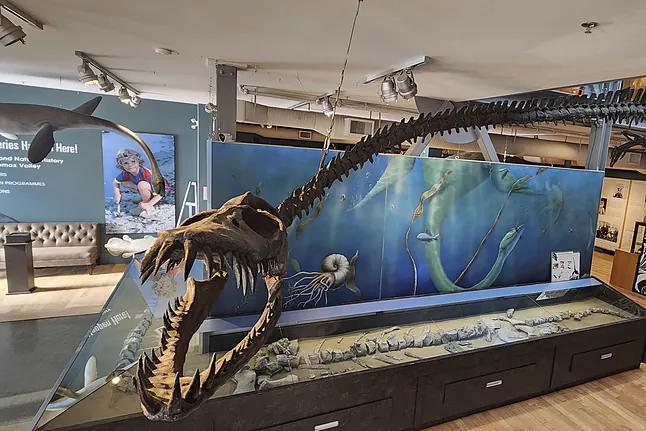A group of fossils of Elasmosaurus, a marine reptile with an extremely long neck that lived in the Upper Cretaceous period in what is now the USA, 80.5 million years ago, has just been formally identified as belonging to a new genus of marine monster, which scientists describe as "very strange," as it is unlike any known before.
Scientists have named it Traskasaura sandrae. It was twelve meters long with a large group of heavy and sharp teeth, ideal for crushing. Its enormous neck had at least 36 cervical vertebrae and 50 bones. Although not much is known about its behavior, the bones indicate a great ability to swim downward, which could have made it one of the first plesiosaur taxa capable of hunting prey from above, as just published in the Journal of Systematic Palaeontology.
In fact, it is believed that the combination of its unusual characteristics is related to its hunting style, where it used this ability to launch itself onto its prey, probably the abundant ammonites, an extinct mix between a mollusk and a squid, that inhabited the region. Its teeth were ideal for crushing their shells.
The first fossil of this marine monster, now renamed as Traskasaura, was discovered in Upper Cretaceous rocks in 1988 along the Puntledge River on Vancouver Island, in the so-called Haslam Formation. Since then, additional fossils of three animals have been recovered, including a right humerus, and a juvenile skeleton composed of thorax, waist, and limbs. The scientific confusion, they assure, was understandable, as it presented a very peculiar mix of primitive and derived traits, such as a shoulder different from any plesiosaur seen before.
These fossils recently became famous after being adopted by the province of British Columbia (Canada) and declared the official fossil emblem, following a provincial-level public survey conducted in 2018, in which Elasmosaurus received 48% of the votes. They are now on public display at the Courtenay and District Museum and Paleontology Center in Courtenay.
"The Pacific Northwest was a region known for its rich marine life and hosted strange and wonderful marine reptiles from the dinosaur era, but now it finally has its own Mesozoic reptile," notes the study's lead author, Professor F. Robin O'Keefe, from Marshall University in West Virginia. "The fossil record is full of surprises. It is always gratifying to discover something unexpected. When I first saw the fossils and realized they represented a new taxon, I thought it might be related to other plesiosaurs from Antarctica, but my Chilean colleague, Rodrigo Otero, had a different opinion, and he was right: Traskasaurais a strange, convergent, and fascinating beast."
In the initial description of the fossils in 2002, experts were hesitant to establish a new genus based solely on the adult skeleton of the discovered Elasmosaurus. Until a new partially "excellently preserved" skeleton allowed this latest international team of scientists from Canada, Chile, and the USA to shed new light on the morphology of the Puntledge River Elasmosaurus and finally identify it as a new genus and species.
Its name, Trakasaura sandrae, is due to Michael and Heather Trask, residents of Courtenay, British Columbia, who discovered the original specimen in 1988. It is completed with the Greek word sauros, meaning lizard. As for Sandrae, it pays tribute to Sandra Lee O'Keefe, a team member who identified the fossils in 2002, who battled breast cancer. "In memory of all of them," writes the team of authors.
